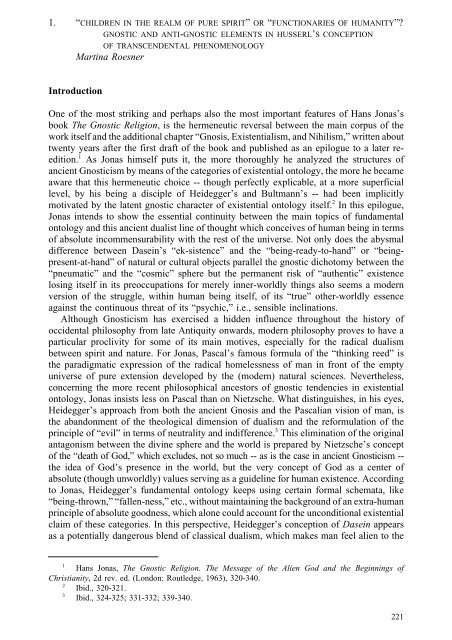[Andrzej_Wiercinski_(ed ... - WordPress.com
[Andrzej_Wiercinski_(ed ... - WordPress.com
[Andrzej_Wiercinski_(ed ... - WordPress.com
You also want an ePaper? Increase the reach of your titles
YUMPU automatically turns print PDFs into web optimized ePapers that Google loves.
1. “CHILDREN IN THE REALM OF PURE SPIRIT” OR “FUNCTIONARIES OF HUMANITY”?GNOSTIC AND ANTI-GNOSTIC ELEMENTS IN HUSSERL’S CONCEPTIONOF TRANSCENDENTAL PHENOMENOLOGYMartina RoesnerIntroductionOne of the most striking and perhaps also the most important features of Hans Jonas’sbook The Gnostic Religion, is the hermeneutic reversal between the main corpus of thework itself and the additional chapter “Gnosis, Existentialism, and Nihilism,” written abouttwenty years after the first draft of the book and publish<strong>ed</strong> as an epilogue to a later re<strong>ed</strong>ition.1 As Jonas himself puts it, the more thoroughly he analyz<strong>ed</strong> the structures ofancient Gnosticism by means of the categories of existential ontology, the more he becameaware that this hermeneutic choice -- though perfectly explicable, at a more superficiallevel, by his being a disciple of Heidegger’s and Bultmann’s -- had been implicitlymotivat<strong>ed</strong> by the latent gnostic character of existential ontology itself. 2 In this epilogue,Jonas intends to show the essential continuity between the main topics of fundamentalontology and this ancient dualist line of thought which conceives of human being in termsof absolute in<strong>com</strong>mensurability with the rest of the universe. Not only does the abysmaldifference between Dasein’s “ek-sistence” and the “being-ready-to-hand” or “beingpresent-at-hand”of natural or cultural objects parallel the gnostic dichotomy between the“pneumatic” and the “cosmic” sphere but the permanent risk of “authentic” existencelosing itself in its preoccupations for merely inner-worldly things also seems a modernversion of the struggle, within human being itself, of its “true” other-worldly essenceagainst the continuous threat of its “psychic,” i.e., sensible inclinations.Although Gnosticism has exercis<strong>ed</strong> a hidden influence throughout the history ofoccidental philosophy from late Antiquity onwards, modern philosophy proves to have aparticular proclivity for some of its main motives, especially for the radical dualismbetween spirit and nature. For Jonas, Pascal’s famous formula of the “thinking re<strong>ed</strong>” isthe paradigmatic expression of the radical homelessness of man in front of the emptyuniverse of pure extension develop<strong>ed</strong> by the (modern) natural sciences. Nevertheless,concerning the more recent philosophical ancestors of gnostic tendencies in existentialontology, Jonas insists less on Pascal than on Nietzsche. What distinguishes, in his eyes,Heidegger’s approach from both the ancient Gnosis and the Pascalian vision of man, isthe abandonment of the theological dimension of dualism and the reformulation of theprinciple of “evil” in terms of neutrality and indifference. 3 This elimination of the originalantagonism between the divine sphere and the world is prepar<strong>ed</strong> by Nietzsche’s conceptof the “death of God,” which excludes, not so much -- as is the case in ancient Gnosticism --the idea of God’s presence in the world, but the very concept of God as a center ofabsolute (though unworldly) values serving as a guideline for human existence. Accordingto Jonas, Heidegger’s fundamental ontology keeps using certain formal schemata, like“being-thrown,” “fallen-ness,” etc., without maintaining the background of an extra-humanprinciple of absolute goodness, which alone could account for the unconditional existentialclaim of these categories. In this perspective, Heidegger’s conception of Dasein appearsas a potentially dangerous blend of classical dualism, which makes man feel alien to the1Hans Jonas, The Gnostic Religion. The Message of the Alien God and the Beginnings ofChristianity, 2d rev. <strong>ed</strong>. (London: Routl<strong>ed</strong>ge, 1963), 320-340.2Ibid., 320-321.3Ibid., 324-325; 331-332; 339-340.221


